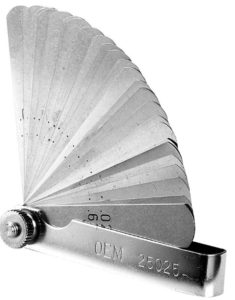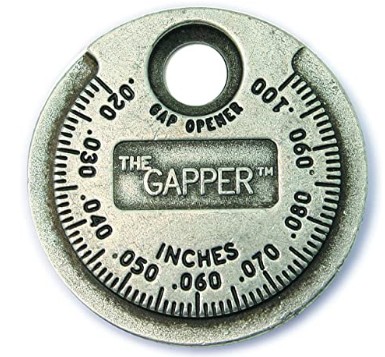The condition of spark plugs directly affects the engine’s performance from misfiring during acceleration to cold-starting. Sparks plugs are highly durable and rarely require maintenance except for the gap adjustment of its electrode and periodic cleaning or replacement. Typically though, even quality spark plugs are bound to wear out over time and lose their gap. The gap between the two electrodes should be precise and specific to every engine. When this gap increases or reduces, the spark plug won’t fire efficiently.
Adjusting the distance between the two electrodes on your spark plus is called gapping. Confirm the recommended gap for your engine, and measure and adjust the gap using a feeler gauge. Reduce or increase the gap between the electrodes accordingly. The following steps explain how to gap your spark plugs with a gap gauge or feeler gauge:
- If you are gapping used spark plugs, you should clean them first. Scrub it with a soft wire brush and some quick-drying alcohol. Removing debris and soot will help with more precise readings. If you are gapping new spark plugs, skip the cleaning part.
- Confirm the recommended gap for your spark plugs. Keep in mind that different makes and models of cars work with different spark plug gaps. You can get this information from your car owner’s manual, the emissions sticker in the swingarm, or your local automotive dealership.
- Slip the gap gauge between the electrodes to determine the existing measurement of the gap. Verify the reading with the recommended setting for your car.
- Find the correct gap gauge reading and make the necessary adjustments.
- If the gap is wider than the recommended distance, you can constrict it by pressing the electrode on the flat hard surface. Make minor adjustments until you get to the right setting. Be gentle when bending since the electrodes weaken under too much pressure.
- If the gap is too narrow, insert the electrode through the hole on the gapping tool and widen the gap like a bottle opener. Lift the top electrode using minor adjustments, measure the gap and repeat until you achieve the recommended gap range. Be gentle enough not to damage the bottom electrode.
- The feeler gauge should fit snug between the electrodes.
- Note that the more adjustments you make, the weaker the electrodes become, and they can break off from the intense pressure and heat during combustion. Therefore, if you pry one spark plug too much, you should get a new one and try re-gapping it.
- You should always confirm the gas size and re-gap any new spark plugs before installing them.
Check this too: How Often Should You Change Spark Plugs?
Best gapping tools for measuring and gapping your spark plugs
We have recommended our favorite gapping tools to help you with accurate and precise measurements to adjust your spark plugs. We have two styles to choose from depending on what you find easiest to use, the feeler gauge and the ramp style gauge.
1. OEMTOOLS 25025 26 Blade Master Feeler Gauge
This OEMTOOLS Blade Master Feeler gauge is excellent for measuring and adjusting spark plug gap size. Each of the 26 hardened, tempered steel blades is laser etched with SAE and metric sizes for accurate readings.
Features
- Sizes range from 0.0015 inch (0.038 mm) to 0.025 inch (0.635 mm)
- 26 blades
- Material: tempered blades
- Chrome-plated main shaft
Pros
- It is straightforward to use
- It has well-calibrated blades
- Easy to clean
Cons
- The joint can come apart
- The blades can rust when exposed to the elements.
- Requires lubrication
2. CTA Tools 3235 Ramp-Type Spark Plug Gapper
The CTA Spark Plug Gapper is a ramp-style range made of durable steel with a die-casted construction. It has an easy-to-read scale that allows you to measure and adjust spark plug sizes.
Features
- Sizes range from 0.02 inches (0.508 mm) to 0.1 inches (2.54mm) with 0.01mm increments
- Ram style gauge
- Made of steel
- Diameter of 38.0mm
Pros
- It is cheap.
- It has a precise scale that is easy to read, which includes inches and millimeters readings.
Cons
- It does not give the most accurate measurements.
- The steel material is of low quality.
Do spark plugs need to be gapped?
Nowadays, it is unnecessary to gap your spark plugs as they usually come pre-gapped from the factory, unlike in the past when it was mandatory to gap them before installation. However, we advise confirming that the gap on your new and old spark plugs is precise just because the pre-selected setting may not the right for your engine. Shipping logistics may also alter the gap. For instance, if you get spark plugs for your V8, you will be able to install eight pre-gapped spark plugs without gap adjustment. But for the same spark plugs to match a 6-cylinder engine, you will need to gap the six spark plugs correctly.
What happens if you don’t gap spark plugs correctly?
Typically, a working spark plug will create the spark that ignites the fuel and air mixture in the engine to produce power. The gap between the electrodes should be wide enough that the electrodes do not touch but narrow enough to jump between the two electrodes. The gap size affects the spark plug’s firing temperature, which affects the fuel and air combustion in the engine.
If the gap is too narrow, it reduces the amount of space required for the spark to light and ignites the engine’s air and fuel mixture. Therefore, the spark has less distance to travel, preventing the voltage from staying hot enough to fire the engine. The spark will be too weak, causing significantly low engine efficiency or no ignition at all.
If the spark plug gap is too wide, the voltage has too much travel distance to ignite the engine. The spark will not reach the other electrode causing a rough-running engine or a misfire, and it will also require more time to fire the engine.
How do you gap spark plugs without a gapping tool?
Sometimes you may not be able to access any gapping tools for your spark plug. However, you can still easily gap them with coins, but it will not be accurate. This method is more suitable for gaps within the range of 0.028 inches and 0.06 inches since we will be using dimes and pennies. The penny is about 0.06 inches, while the dime is 0.053 inches thick. Verify the recommended gap size on the spark plugs suitable for your engine. If your spark plug gap requires either of those measurements, you do not need a feeler gauge. However, it is best to get yourself a feeler gauge for more accurate adjustments; they are cheap and available in local auto shops. Wrong estimation of the gap will eventually lead to engine and performance issues.
Conclusion
The spark plug is responsible for igniting the air and fuel mixture in the engine to produce power. The gap between the electrodes where the spark appears is essential in the functioning of your engine. A gap that is too wide or narrow will cause misfiring, reduce horsepower or prevent the engine from starting altogether. Its important to always confirm the recommended gap size to avoid installing an incorrectly set spark plug.


